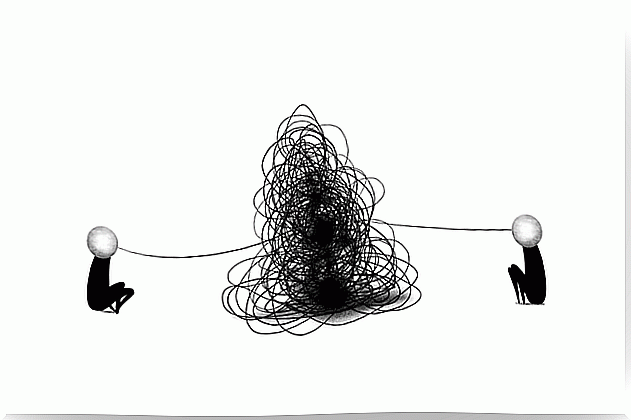Anger, An Emotion That Seduces Our Inner Monologue

Anger is an emotion that seduces our inner monologue, that hijacks us in thought, word and action. A defensive weapon that, misused, can turn against us and do real damage if we let it grow.
We don’t like it but, nevertheless, we have seen that on many occasions we cannot help it. This is undoubtedly because this is a natural tool of our evolution to deal with the injustices that we perceive.
The fact that a child strongly and insistently claims that his brother has taken a toy from him is, in essence, a way of asserting his interests and preventing his integrity from being undermined. The problem of this emotion will come if the child does not come out of his protest and cannot manage an advance.
In other words, if we remain anchored in that “the toy has been taken from us” , our physiological and cognitive systems will quickly be trapped in a spiral of negative feelings and thoughts that do not allow progress.
The idea of vulnerability behind anger

We do not like to show anger in public, as we understand that it implies a condemnation of our personal and emotional qualities. We are afraid to express it, so we tend to show it only in our home, accompanied by those people who know us and who, therefore, we can hope that they will not judge us for it.
This emotion, unfairly treated, is frowned upon by our society. However, as we have highlighted here on many occasions, expressing it offers us information about what is bothering us, giving us the option to examine ourselves and seek balance.
There is a main reason why we punish the expression of anger, this is that we confuse the anger or the excessive and uncontrolled expression of our annoyance. In other words, we equate exploding and screaming with frowning when something is uncomfortable.
But really, we can say that anger is not equivalent to anger, but that the latter responds to the mismanagement of what makes us angry and torments us. We make a beach out of a grain of sand by not getting rid of it in time. That’s when the mess starts.
Why? Because we make isolated events the continuous focus of our attention, preventing ourselves from undoing an emotional snowball that rolls and rolls, getting bigger and bigger.
Comprehension and expression, the first steps of cooling

When we become aware of our feelings and emotions, we can take one more step to manage them and transform them into useful and not harmful. Let’s say we hit the brakes when we express, because we release a large part of the affective load that promotes the arrival of negative and potentially threatening moods for our balance.
Returning to the example of the child’s anger at the theft of the toy helps us to appreciate how it is normal and adaptive to promote equality through protest and the request that the violated freedom be restored.
But as we have said, once anger arises in the face of physical or psychic threat, it is important that we operationalize those feelings and emotions that have been born in us. Otherwise, we will be dominated by thoughts and actions that only promote discomfort without worrying about solving it.
Anatomy of our angry emotional brain

When we perceive through our senses that an injustice or injury has been committed with respect to our person or something that is of personal interest, our limbic system (amygdala and adjacent structures) receives a spark that starts the machinery.
In other words, our nervous system is activated and, with it, our body and our mind are “turned on” to give way to action. For its part, the neocortex is in charge of calculating and giving way to a reaction more or less adjusted to the situation.
Thus, limbic discharge involves the release of catecholamines, which helps us to react decisively and quickly. At this time, and if the activation is high, we can look like fire. Our cheeks can heat up, our knuckles turn pale, and our minds go a thousand miles an hour.
On the other hand, the activation of the adrenocortical branch promotes a prolonged activation that predisposes us to action for a longer time. This hypersensitivity manages to dominate our mind, which tends to feed on the menu of spiraling negative thoughts.
In other words, any small touch will make us jump, building anger after anger and cognitively incapacitating us more and more, since we will not be able to reason adequately, which will lead us to underestimate thoughts that would stop the climb.
The emotional distance, necessary to cool the anger

As we can see, the key to managing anger correctly is to appease the excitement. This is accomplished in two ways:
- Taking physical and emotional distance from the situation to prevent the adrenaline rush from dominating us and feeding through the reigning irritability.
- Stopping our internal monologue. That is, to distract ourselves and not validate the thoughts that dominate our mind.
This is what makes us affirm that anger is an emotion that seduces our internal dialogue, promoting “more than convincing” arguments that what has angered us is the origin of all evil.
One hostile thought after another end up building the chain of anger until they manage to swell it and turn it into anger. Therefore, if we question some of those links that take the form of categorical reasoning, we will be able to appease the mental scene that promotes excessive discomfort.
Thus, little by little, the fire may disappear when we stop adding fuel to it, helping us to contemplate the situation far from the chains that previously dominated us. This is the first step to emotional well-being.
Interesting reading:
Goleman, D. (2001). Emotional intelligence Editorial Kairós. Barcelona.









